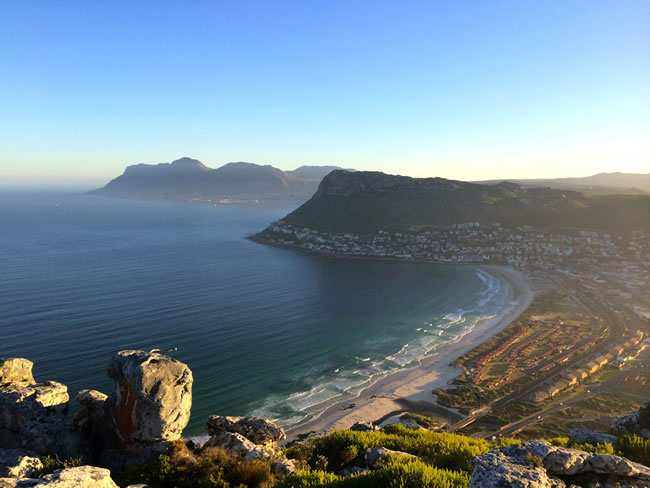6-8 October 2016
Cape Town and surrounds
Cape Town and its surrounding mountains contain the highest
density of plants species in the highly diverse global biodiversity hotspot,
the Cape Floristic Region. Over 2200
species are found in the Table Mountain National Park stretching from the City
centre with its iconic flat topped Table Mountain to Cape Point at the
southernmost tip of the peninsula.
October, our southern Spring, offers an ideal time to visit Cape Town
and experience the diversity of flora and their remarkable pollinators since
many of the plants are in flower and the weather is generally mild and sunny. With accommodation along the shores of False
Bay you may be lucky enough to spot the Southern Right Whales who overwinter in
this area, or you may want to pop-down to the penguin colony near Simon’s Town.

This tour will be hosted by the South African Environmental
Observation Network’s (SAEON) Fynbos Node.
While visiting some of our research platforms we will provide expert
insight into the diversity and ecology of this wonderful region.
Cape of Good Hope
Nature Reserve, established in 1939 is the oldest part of the Table
Mountain National Park. It offers
magnificent scenery of rugged landscapes, pristine beaches and the often stormy
ocean. The reserve contains permanent vegetation plots, established in 1966, that
are one of SAEON’s prime sites for unravelling the diverse drivers of global
change and their impact on the ecology of fynbos. Although the wildlife-viewing does not rival
that of the Kruger National Park, one may spot some of the local antelope,
mischievous baboons, sun-bathing rock hyrax, or tortoises warming after the
cold winter. Both marine and terrestrial birdlife may present some surprises: the iridescent sunbirds and Cape sugarbirds
will be out collecting nectar, and a multitude of seabirds will provide good
use for your binoculars.
Notes on route: Stop at Silvermine on the way to introduce
them to fynbos, its fire ecology and look for pretty flowers. Continue to Cape
Point. Stop at view point midway down the main drag to get a feel for the
reserve and discuss the plots and the “global change” findings. Depending on
timing, either head to Gifkommetjie for lunch or head to the lighthouse to walk
up to the lighthouse and discuss some of the history of the area etc (swap
order as appropriate). Drive to Olifantsbos (thicket, forest and fynbos
dynamics) and walk the Sirkelsvlei circular route (~1.5-2hrs with chatting).
Those not keen can hang out on the beach.
Jonkershoek and the
Winelands. Jonkershoek, near the historic university town of Stellenbosch,
is the site of streamflow monitoring experiments set up from 1938 onwards.
Evidence emanating from these experiments showed that the non-native pine
plantations used more water than the indigenous fynbos, leading to the
establishment of Working for Water, one of the biggest poverty-relief based
biodiversity conservation programmes in the world. Jonkershoek is now
instrumented with modern climate and streamflow equipment to continue this long
legacy of monitoring so that we can explore climate change trends and its
impacts on streamflow. In the second
spring since a wildfire, Jonkershoek will present a diversity of flowering
geophytic plants, against a background of spectacular mountains. Jonkersheok
also provides the opportunity to explore the role that fire plays in
maintaining the balnce between fynbos and forest. A visit to a wine farm will provide an
opportunity to taste some of the local wines (and lunch) and learn about
business-conservation partnerships to secure remnants of threatened lowland
fynbos and renosterveld
Lowland vegetation and township biodiversity initiatives. In a growing city, saving natural vegetation, no matter how rare and unique, from bulldozers is a major challenge. Visit one of the City’s lowland reserves and meet some of the dedicated staff(Follow this with a visit to a township biodiversity project, the Seawindsmedicinal plant project (herbanisation) , where members of the local community use surplus land to cultivate medicinal plants.
Itinerary:
5th October: Guests arrive at accommodation
6th October: Visit to the Cape of Good Hope section of the Table Mountain Park via scenic routes.
7th October: Visit to the historic Jonkershoek Catchment Experiments and wine lands
8th October: Visit remnants of lowland vegetation types and explore the challenges facing conservation of these rare vegetation types. Visit Seawind Herbanisation -township project to grow medicinal plants in bare areas (Leif Petersen). Afternoon-free to explore Cape Town or climb Table Mountain or visit Kirstenbosch Gardens
9th October: Guests depart for Skukuza
Notes:
- Organisers retain the right to cancel the tour if fewer than 6 people wish to take up this tour and adjustment may be made in price to accommodate smaller numbers.
- Numbers will be restricted to 20 participants
- Moderately-good fitness levels will enable the participants to enjoy this tour more fully
- Guests will be expected to make their own travel arrangements to and from Cape Town.
What to bring?
- Comfortable shoes for walking
- Stout shoes for walking on rough paths
- Hat for sun
- Raincoat and fleece or jacket for possible wet or cold weather
- Other equipment
- 1 litre water bottle
- Small backpack
- Sun protection cream
- For personal preference - binoculars, camera, magnifying lens
What is included?
- Four nights accommodation in Simons Town on a bed and breakfast basis based on two people sharing a room.
- Transporation in an airconditioned vehicle and drive from 05 October (Cape Town Airport) to 09 October (Cape Town Airport) as per the itinerary
- Entrance Fees as per the programme
- Packed lunches on 6 & 8 October
- Wine Tasting and picnic at a Wine Estate (Weather permitting)
- Visit to Kirstenbosch Gardens and Hike
Domestic Flights
And
R8164.00 per person singleIt is suggested that all participants make their own way to Cape Town International Airport on 05 October 2016
Transporation will depart Cape Town Airport for the hotel in Simons Town at 15.00 hrs on the 5th of October. (Subject to change once all participants have registered and may change to accommodate everyone based on incoming flights)
It is suggested that all particpants book flights with similar departure times from Cape Town to Johannesburg on the 09th of October, reason being that..
- Transportation in a coach is included in the tour cost, the coach will only depart at a set time for one journey from the hotel to the airport.
- To enable delegates for the main conference make the domestic flight from Johannesburg to Skukuza or those who choose to drive from Johannesburg to Kruger Park have enough time to reach the gates of the Kruger National Park before closing time.
Suggested flights are:
- MN.118 departing Cape Town at 08.10 hrs arriving at Johannesburg Airport at 10.10 hrs
Or
- JE.144 departing Cape Town at 08.55 hrs arriving at Johannesburg Airport at 10.50 hrs
Please note that there is one daily DIRECT flight from Cape Town to Skukuza Airport (Inside Kruger Park) but these flights are extremely expensive due to high demand, however you may at any time contact the conference organiser ilter2016@ie.co.za to assit you with flight info.
Cost and Booking:
The cost for this is R5664.00 per person sharing And R8164.00 per person single
Please email ilter2016@ie.co.za for futher information to book this field
trip and also should you wish to extend your stay in Cape Town or any other
destination before or after your trip.
Should wish to particpate in this field trip you may add it
to your invoice when you register for the conference by clicking on
OPTIONS –
FIELD TRIPS - FYNBOS










